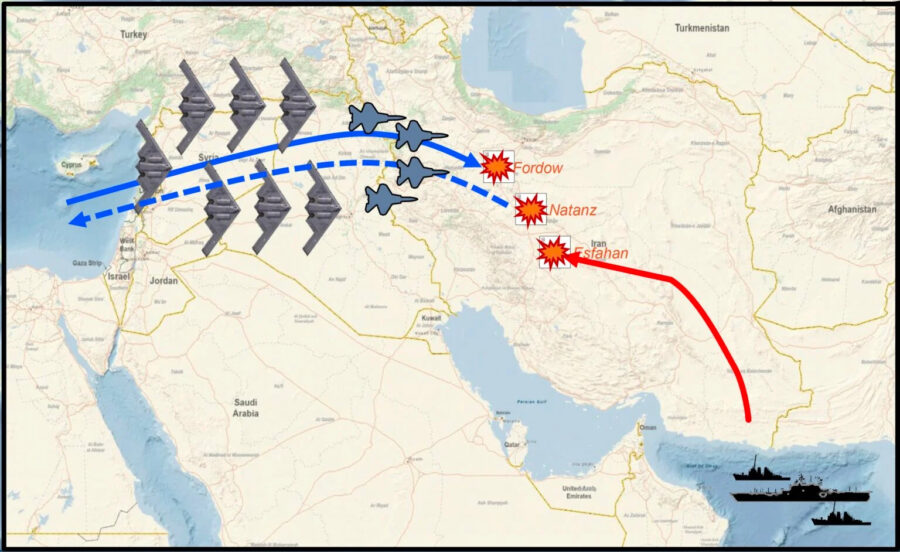U.S. B-2 Bombers Hit Iranian Nuclear Sites in Massive Strike

Seven U.S. Air Force B-2 Spirit bombers, backed by more than 30 Tomahawk missiles launched from an Ohio-class submarine, struck three major Iranian nuclear sites—Natanz, Isfahan, and Fordo—in a coordinated mission confirmed by the Pentagon on Sunday June 22. The operation, code-named Operation Midnight Hammer, marked a significant escalation in U.S. military action against Iran’s nuclear infrastructure.
President Donald Trump announced the operation in a Saturday night address, declaring that Iran’s “key nuclear enrichment facilities have been completely and totally obliterated.”
The bomber fleet departed Whiteman Air Force Base, Missouri, on Saturday for a round-trip mission lasting more than 24 hours. Early Sunday morning local time, the aircraft dropped 14 GBU-57/B Massive Ordnance Penetrators (MOPs) on the hardened nuclear sites in Natanz and Fordo. These 30,000-pound bombs are the only known weapons capable of penetrating the deeply buried uranium enrichment facilities.

“In total, U.S. forces employed approximately 75 precision-guided munitions,” said Gen. Dan Caine, Chairman of the Joint Chiefs of Staff, at a Pentagon briefing. “This includes the first-ever operational use of the GBU-57 Massive Ordnance Penetrators.”
The B-2s were supported in flight by KC-135 and KC-46A Pegasus aerial refuelers. As the aircraft entered U.S. Central Command airspace, an escort of fourth- and fifth-generation U.S. fighter jets, including F-35s, targeted Iranian surface-to-air missile sites to clear a path for the bombers. Iranian air defense systems had already been weakened by Israeli strikes launched earlier this month.

A second formation of B-2s flew westward in a decoy mission over the Pacific. Over 125 aircraft participated in the operation, including ISR (intelligence, surveillance, and reconnaissance) and refueling units. It is unclear whether aircraft from the Carl Vinson Carrier Strike Group were involved.
An unnamed U.S. submarine launched more than 24 Tomahawk missiles at the Isfahan site following the B-2 strike. While officials did not confirm the vessel’s identity, the USS Georgia (SSGN-729) has been operating in the region since September and is capable of launching over 150 Tomahawks.

Following the operation, President Trump called for de-escalation, stating on Truth Social: “Now is the time to come forward for peace.” Secretary of Defense Pete Hegseth echoed the message, emphasizing that the operation was narrowly focused on Iran’s nuclear infrastructure.
As of Friday June 20, the Carl Vinson and Nimitz carrier strike groups were operating in the North Arabian Sea. The U.S. Navy also deployed Arleigh Burke-class destroyers to the Red Sea and Mediterranean, with five ballistic missile defense-capable ships positioned to intercept potential Iranian missile launches targeting Israel or U.S. interests.
Iranian leaders have warned that U.S. strikes could escalate the conflict. Supreme Leader Ayatollah Ali Khamenei said any attack would lead to “irreparable damage.” Iranian-aligned militias, including the Houthis in Yemen and Kata’ib Hezbollah in Iraq, have threatened retaliation.
Houthi officials warned that they would resume targeting U.S. vessels in the Red Sea if Washington continues military operations against Iran. Kata’ib Hezbollah also threatened U.S. bases in the region, with experts warning of potential tit-for-tat retaliation similar to the aftermath of Qassem Soleimani’s death.
“I believe the Houthis, Kata’ib Hezbollah, and other Iranian-backed groups are most likely to attack U.S. interests,” said Mohammed Albasha, a regional analyst. “We’ve entered uncharted territory tonight.”
Late Saturday, President Trump issued a stark warning: “ANY RETALIATION BY IRAN AGAINST THE UNITED STATES OF AMERICA WILL BE MET WITH FORCE FAR GREATER THAN WHAT WAS WITNESSED TONIGHT.”
Iran’s Parliament has voted to close the Strait of Hormuz, although the Supreme National Security Council must approve the move. Meanwhile, shipping giant Maersk confirmed on Sunday it will continue sailing through the strait, despite regional tensions.
Related News: https://airguide.info/category/air-travel-business/defense-military/
Sources: AirGuide Business airguide.info, bing.com, news.usni.org, reuters.com
